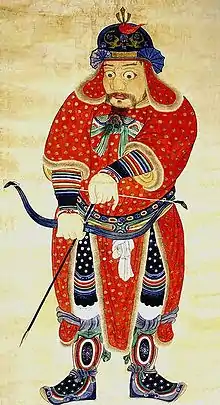Yun Gwan
Yun Gwan (12 July 1040 – 15 June 1111) was a general of Goryeo who was known for training a seventeen-thousand man army and leading it to victory against the Jurchens tribes.
| Yun Gwan | |
 | |
| Korean name | |
|---|---|
| Hangul | 윤관 |
| Hanja | 尹瓘 |
| Revised Romanization | Yun Gwan |
| McCune–Reischauer | Yun Kwan |
Background
Yun Gwan is from the Papyeong Yun (many of this clan also uses, the PapPyong "Yoon" the phonetic spelling for the clan name). His military career began when he passed the state civil examination. According to the Yun family history book, Yun Gwan was born on July 12, 1040 and died on June 15, 1111. (Goryeosa also mentions he died on June 15, 1111.) Koreans dedicated a large statue of General Yun Gwan in a small park near the Seoul Central Train Station which describes his contribution to Korean national history.
The Jurchen Expedition
Jurchen tribes lived to the north of Goryeo. The Jurchens always rendered tribute to the Kings of Goryeo, but the Jurchen tribes grew strong, and were soon united under Wanyan. They began to violate the Goryeo-Jurchen borders, and eventually invaded Goryeo. Goryeo, however, did not have a powerful army at that time, due in part to a century of peaceful existence. With the invasion of the Jurchen, King Sukjong ordered all available soldiers into battle, but this ended in defeat. General Yun Gwan convinced the Jurchen leaders to pull their troops back, and this ended the invasion of the Jurchen.
Victory over the Jurchen
After experiencing the invasion by the Jurchen, Yun Gwan realized that Goryeo lacked efficient cavalry units, and requested permission from King Sukjong to train and reorganize the current Goryeo military into a professional army that would contain decent and well-trained cavalry units. Finally, in 1107, General Yun led the newly formed Goryeo army, a force of approximately 17 thousand men called Byeolmuban, and attacked the Jurchens tribes. Though the war lasted for several years, the Jurchen were ultimately defeated, and surrendered to Yun Gwan. To mark the victory, General Yun built nine fortresses to the northeast of the Goryeo-Jurchen borders (Hangul:동북 9성, Hanja:東北 九城). In 1108, however, General Yun was given orders to withdraw his troops by Goryeo's new ruler, King Yejong. Due to manipulation and court-intrigue from opposing factions, he was discharged from his post. Along with this, the opposing factions fought to make sure that the new nine fortresses were returned to the Jurchens. Soon after, Yun Gwan was released from his prison in 1110, and was offered a chance to return to his duties as general, but he gently refused and returned to his hometown. A year later, in 1111, Yun Gwan died.
Aftermath
After the death of Yun Gwan, the Jurchen destroyed the Liao dynasty, and established the Jin dynasty. With the rise of the Jin, Goryeo was no longer able to trade with the Song Dynasty or any of the other neighboring nations, and became isolated, which contributed to the weakening of the kingdom.
Dispute
The extent of Yun Gwan's military campaigns has been in dispute for centuries. While the general belief is that his nine fortresses were built in present-day Hamheung in North Korea, a number of historical sources seem to indicate that Yun took parts of Manchuria for Goryeo, temporarily claiming the land of Goryeo's ancestors, Goguryeo.
Family Feud
Due to wars and invasions, the location of Yun Gwan's tomb was lost until the 18th century. Yun Gwan's tomb was located near another tomb belonging to the Sim clan. Because of this a family feud erupted between the Yuns and Sims lasting 300 years.[1][2][3]
